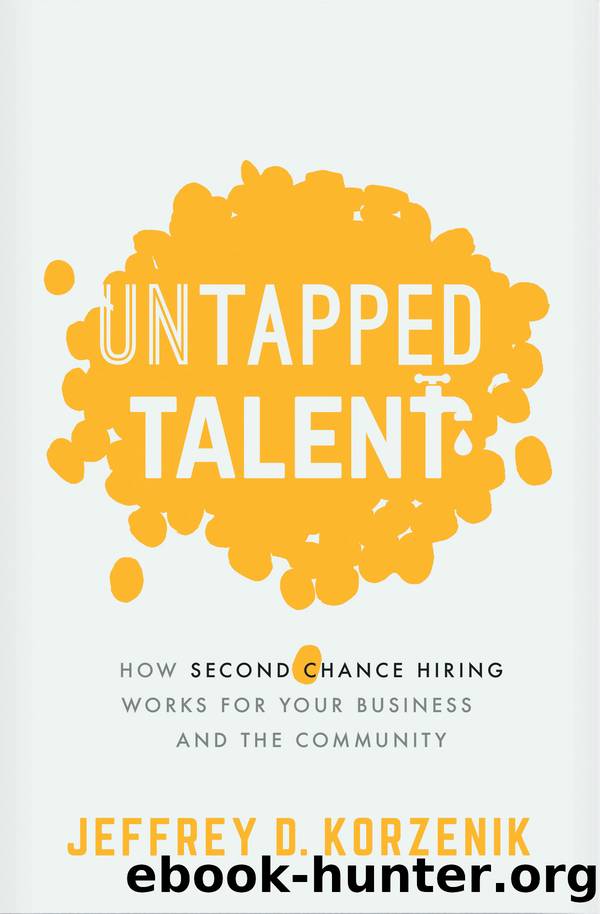Untapped Talent by Jeffrey D. Korzenik

Author:Jeffrey D. Korzenik
Language: eng
Format: epub
Publisher: Harpercollins Leadership
Published: 2021-02-19T00:00:00+00:00
Laying Down the Hammer: Accountability
At some point, the internal communication and legal viability groundwork are done. Some leaders may be fortunate to have the executive team and the employee base embrace second chance hiring, but this is probably the exception. Realistically, a leader will reach a level of lukewarm compliance, and maybe even some pockets of passive-aggressive resistance. Particularly in large organizations (the largest firm Iâve worked for had more than a quarter million employees when I was there), weâve all seen workers âslow-walkâ or just give lip service to initiatives they oppose. At some point, the leader simply has to make the decision to go forward and require accountability.
Jeff Brown started his successful second chance program with a quotaâsix hires. This would ultimately grow a hundredfold (literally!) organically, but was still a modest goal for a company with thousands of workers. âIf you canât find six qualified hires with records in the city of Philadelphia, the problem is not the applicant pool,â Brown reasoned.
The vast majority of second chance employers started with small trials. One chief human resource officer in the hospitality business shared with me that his program started by taking a chance with a single individual and grew to four hundred second chance hires, the founding of a major reentry nonprofit, and successfully petitioning state regulatory bodies to broaden career opportunities for people with records, bringing to life the proverb âFrom little acorns do mighty oaks grow.â His advice: âIf they earned the right to a second chance, I think that we in the employment world should give them an opportunity. It has to be one that is very controlled in the beginning so that companies and hiring managers and supervisors gain their confidence in dealing with a group like this. Itâs not that these people are all that different, itâs just that they have very little experience and confidence with them.â Of course, it is far better to have a trial with several hiresâevery manager knows that not every employee will work out, even among hires with pristine credentials.
Beyond quotas, managers and executives have numerous tools to encourage support. Depending on the industry, variable compensation (bonuses) is commonly tied to performance metrics, and some aspect of second chance hiring can certainly be incorporated. Even without a monetary bonus structure, performance reviews and advancement opportunities are powerful incentives in any company. The success of a second chance employee, not merely the fact of hiring, is the corporate goal, so any metric should be well thought out to ensure alignment. As noted in Chapter Fourâs discussion of potential nonprofit partners, measuring placement and not success can lead to bad hires that can undermine the entire initiative.
Download
This site does not store any files on its server. We only index and link to content provided by other sites. Please contact the content providers to delete copyright contents if any and email us, we'll remove relevant links or contents immediately.
Storytelling for dummies by Andrea Fontana(1493)
Effortless by Greg McKeown(1434)
The Practice by Seth Godin(1404)
Mastering Blockchain by Lorne Lantz(1392)
Blockchain Quick Reference by Paul Valencourt & Samanyu Chopra & Brenn Hill(1149)
Mastering Blockchain by Lorne Lantz & Daniel Cawrey(909)
The wind in the willows by Kenneth Grahame(849)
How to Lead by David M. Rubenstein(823)
The Ape in the Corner Office by Richard Conniff(792)
Social Media Engagement For Dummies by Aliza Sherman(711)
Handbook of Big Data Analytics by Unknown(711)
Taking Care of Yourself (HBR Working Parents Series) by Harvard Business Review(698)
Getting Started with Data: The first book you should read to successfully get along with data. by Menegatti Gabriel & Team Simbiose Ventures(693)
FunRetrospectives: activities and ideas for making agile retrospectives more engaging by Paulo Caroli & Tainã Caetano Coimbra(691)
Business Storytelling For Dummies by Unknown(670)
Evernote for Self Publishing: How to Write Your Book in Evernote from Start to Finish by Jose John(667)
Help! My Facebook Ads Suck-- by M. D. Cooper & Jill Cooper(653)
A Leader Listens by Ajay Banga(639)
Genius by Choice: Your unconventional A–Z handbook to enhance your learning process by Remondino Giulia S(638)
